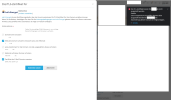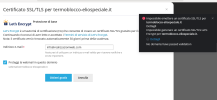Aethem
New Pleskian
- Server operating system version
- Debian 12
- Plesk version and microupdate number
- 18.0.53 Update Nr. 2
Dear Supporter,
I recently switched from one Plesk instance to another provider instance, but I am facing an issue while adding Let's Encrypt certificates automatically to domains. I have attached the error message for your reference.
Let's Encrypt requests to verify the domain with a custom TXT record in the DNS. Could you please guide me on how to fix this issue and enable automatic addition of Let's Encrypt certificates to my domains?
Thank you for your help.
I recently switched from one Plesk instance to another provider instance, but I am facing an issue while adding Let's Encrypt certificates automatically to domains. I have attached the error message for your reference.
Let's Encrypt requests to verify the domain with a custom TXT record in the DNS. Could you please guide me on how to fix this issue and enable automatic addition of Let's Encrypt certificates to my domains?
Thank you for your help.


